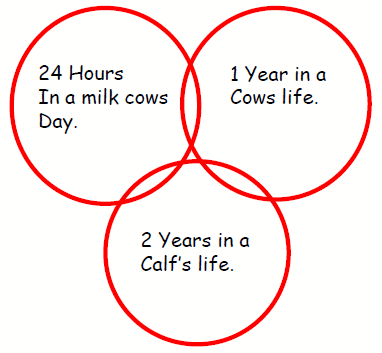Achieving Excellence in Dairying
Published: May 6, 2014
By: Gordie Jones DVM, Central Sands Dairy, LLC,
Take Home Message
There are always going to be problems on a dairy farm, finding the rate limiting problem is the key. Solving that problem, opening that bottleneck, will be the solution to achieving higher performance and profit.
Introduction
One of the very first things you must know about me is my reverence for the dairy cow. She is the reason we have civilization; she truly is the foster-mother of the human race. Without her we do not have civilization; she gave us milk, cheese, other dairy foods, and her meat. She has protected us from smallpox, the most deadly disease known to the human race. Her fat in the form of CLA’s (conjugated linoleic acid) protects us from cancer. So all of us owe the dairy cow a great debt and I have devoted my dairy Veterinary career to taking care of her and making her comfortable.
Lessons Learned from the Past 20+ Years of Trouble Shooting Dairy Farms
Dairy farms of all sizes have bottlenecks and these bottlenecks keep farms from achieving their goals. No matter the size of the dairy farm, there are bottlenecks that keep it from performing at the dairy farm’s potential. When you release a bottleneck, performance can increase until the next bottleneck is reached. As dairy farms across the world increase in size from the 40-100 cow size to the 1,000+ cow size, they can become overwhelming to everyone. They become difficult for some people to understand. One simple thought to help dairymen, Veterinarians and Nutritionists understand all dairy farms, is to break them down into circles. If we understand the circles of dairying we can look at any size dairy farm and find the bottleneck without being overwhelmed.

There are three circles on every dairy farm that we need to understand, and if you completely understand them, most bottlenecks become apparent. The first circle is the 24 hour circle or what does a cow do for 24 hours a day. Things like how often is she milked, how long does she spend in the parlor and holding area, how long is she locked up to be found in heat? When does her feed arrive and how long is the manger empty? Does the dairy farm feed to a clean bunk or do they feed to an extra “weigh back” feed, that is used somewhere else? All of these questions are easy to answer when we know the 24 hour circle of a herd or pen of cows. Just keep asking yourself what does 24 hours look like in the life of a milking cow, and also what does 24 hours look like in the life of the dry cows and heifers.
The second circle starts at the maternity pen, and it is: what does a year look like in the life of a cow? Another way to ask about the circle is how does the just freshening cow get back to the fresh pen a year later? The questions about the year circle might look like these. Where does she freshen, when is she moved into the fresh pen, how long is she in the fresh pen, when is she moved into the breeding pens, when does breeding start, when does breeding quit, how many rations does she get fed? More questions would include when is she dried off, how long is she dry, how many dry cow rations is she fed, what are the rations? And, how is labor detected, when is she moved to be by herself to calve?
The third circle also starts at the maternity pen and this circle belongs to the calf. The circle is: what does 2 years look like in a calf’s life? Questions include, when is she fed colostrum, how much colostrum is she fed, where is she housed and fed until weaning, how many calves are together in the weaning pens?
What is she fed, when is grain introduced, how many heifer rations is she fed, where is she housed until breeding age? More questions include: when is she bred, is she bred by size or age or both? When does she move into the close up pens, how is she handled at calving for the first time?
Think about those three circles on all size dairy farms and if you really understand your circles, or circles on the farms you work with, you can start to identify the bottlenecks to the performance you are trying to achieve and correct them. You can see that any size dairy farm is now much easier to understand and you will not be overwhelmed by large dairy farms.
This paper was presented at the WCDS Advances in Dairy Technology (2012) Volume 24: 129-131.
Authors:
Join to be able to comment.
Once you join Engormix, you will be able to participate in all content and forums.
* Required information
Would you like to discuss another topic? Create a new post to engage with experts in the community.
Create a post16 de julio de 2014
The key factor for achievement in dairy farm is herd management or who manage the farm. Because dairy farm has too many factors( feed, labour, genetic, hygiene, health etc.) which affect success and profitabilty and good herd manager should merge and evaluate these factors and find best way for the achivement of the goals.....
14 de julio de 2014
It is a simple presentation of managing dairy cows. The biggest challenge is labour of trained and committed individuals who are willing to soil their hands. I know people who have abandoned dairy farming because of lack of labour. What are you doing in your country?
23 de mayo de 2014
Ha Duong,
I find that in a big dairy herd in KSA using middle to far east labour - you tend to get labour from non farming back rounds - you need people from dairy farm back rounds - people that are interested and like farm animals - people with an eye that can spot an animal off form early - this is a skill that is acquired from years of farming experience - it is very difficult to get these sort of people in the low cost labour market,
Minh Dang Trading and Servicing Company
23 de mayo de 2014
here in Vietnam we are facing the Man labor who has knowledge of dairy and willing to let their hands dirty at farm work?
How about yours?
13 de mayo de 2014
I don't think this topic is too well named - stating the elementary obvious does not do much for achieving excellence - you can understand the cow all you like - what about owners, management and labour? - the most important thing in achieving excellence is the will - where there is a will there is a way







